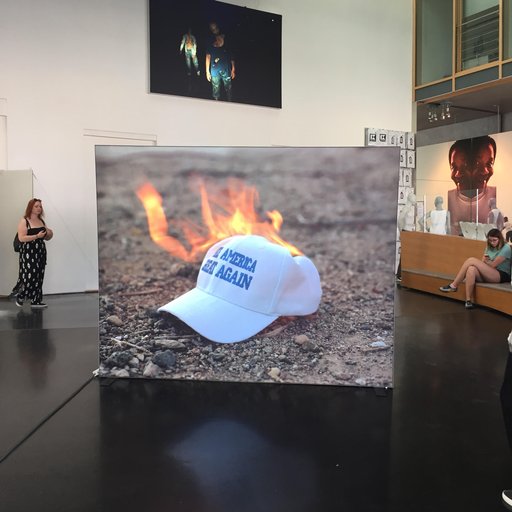Here we look back at the most clickiest, stickiest Artspace articles of 2018. From heavy-hitting interviews and cultural criticism to light-hearted name generators and binge-worthy television comedies, these articles have a little something for everyone.
If you thought the only cut-off ear in the art world was Vincent Van Gogh’s—think again. The grandson and namesake of one of America’s most known art collectors, J. Paul Getty, had his ear dismembered when the 16-year-old was kidnapped in 1973. The kidnappers (who were part of the powerful Italian crime gang known as the 'Ndràngheta) sliced off John Paul Getty III’s ear when his stubborn billionaire grandfather refused to pay the demanded ransom. (Amusingly, even the severed ear didn’t convince J. Paul Getty to pay up.) The savagery of J. Paul Getty doesn't end there. Read up on the unfortunate reputation of one of the art world's most important patrons.
"Apeshit" At The Louvre, "Like Life" At Met Breuer, And The Persistent Whiteness Of Neoclassicism
In the Carters’s “Apeshit” music video, Beyonce, Jay Z, and their dancers upstage some of the most well-known pieces of art history at the Louvre, metaphorically decolonizing a historically white space. Meanwhile, “Like Life: Sculpture, Color, and the Body,” the Met Breuer’s transhistorical survey of figurative sculpture culls works from the 14th century to the present, yet almost entirely excludes non-Western artists and cultures. Here we look at the relationship between ancient Greek sculpture and white supremacism, point out the blatant missed opportunities presented by "Like Life," and ask the art world to not leave it to Beyonce and Jay Z to get the world talking about the whiteness of art institutions.
Watch 12 Devastating TV Comedies Mock the Art World—From Laughter or Pain, You'll Cry Either Way
Comedy has always been a great lens for analyzing the culture at large. Maybe this is why some of our favorite comedic moments are ones that make fun of the art world. There are countless examples in entertainment where the art world is the butt of the joke, because let’s be real, the art world—full of clichés and stereotypes—is such an easy target. Here, we’ve compiled some clips of our favorite laugh-out-loud art-related moments from comedy television. While they reveal how outrageous our whole industry can be, we think we’re definitely getting the last laugh! Our feelings aren't hurt... but our abs are!
If you haven't seen the recent documentary "Generation Wealth," you've missed out on an extraordinary visual history of our culture's growing obsession with wealth. The project by Lauren Greenfield, named by the New York Times as “America’s foremost visual chronicler of the plutocracy,” documents how we export the values of materialism, celebrity culture, and social status to every corner of the globe, and encompasses the film, a gorgeous book published by Phaidon, and a museum exhibition of photographs. More than true wealth, Generation Wealth documents the desperation of those who don’t have but wish they did. Read up on the project here, and see the photos that started it all.
The New Museum’s “Sarah Lucas: Au Naturel” is, surprisingly, the very first U.S. museum retrospective of one of the most celebrated British artists to come out of the '90s. A graduate of London’s Goldsmith’s College, Lucas was originally associated with the Young British Artists (YBA’s), a group that rose to fame in London in the late '80s and early '90s with the support of influential collector Charles Saatchi. While many perceive the artist to epitomize angsty, DIY grunge, in an interview with New Museum’s Massimiliano Gioni Lucas reveals, "I am really not grungy at all." Read about how the artist's aesthetic and process came not from a conscious effort to assimilate with "grunge" culture, but from a lack of financial means and studio space; about the first few shows she ever had; and about the reception of her provocative work.
Salvador Dalí, is not only famous for being the most prominent Surrealist painter, but also for his magnetic, bizarre, and extraverted personality. Donning an impossibly long and severe mustache and a wide-eyed expression, Dalí was a jovial presence in whichever art scene he was in, whether New York, Paris, or Cadaqués. But, in private, he was also quiet, gentle, and inquisitive—at least according to his assistant during the '70s, Baron Roger de Cabrol. Here, we speak with de Cabrol about what it was like to spend time with Dalí, the unsavory reputation the artist had among some of his Surrealist peers, some dirt on Dalí's former wife, and the iconic artist's lasting influence on de Cabrol's work.
How Does Banksy Make Money? (Or, A Quick Lesson in Art Market Economics)
Earlier this year, Banksy stenciled a rat on the exterior clock of a former bank building on 14th Street in Manhattan. Though the entire building is slated for demolition (a developer filed plans to replace it with a 13-story condo building with ground-floor retail space), Banksy’s piece would never see its demise. Less than a week after he painted it, the piece was removed on behalf of the developer, Gemini Rosemont, who is “in the process of examining all of our options before making a decision about next steps,” according to Curbed. It’s probably safe to assume that these “options” involve selling the clock for a bunch of money—none of which the artist will ever see. So then, how does Banksy (and street artists in general) make money?
Jess T. Dugan's Graceful Portraits Capture Transgender People as They Age
Jess T. Dugan has been exploring issues of gender, sexuality, identity, and community for the past decade. Spurred by her own identity as a queer person, Dugan's works fluctuate between internal experience and more outward, socially and politically motivated documentations of the LGBTQ community. Here is a look at some of the most arresting photographs from her show at St. Louis' projects+gallery earlier this year, along with excerpts from interviews conducted with the subjects.
A 1959 Interview with Marcel Duchamp: The Fallacy of Art History and the Death of Art
Here we've excerpted from an Audio Arts interview with Marcel Duchamp, which was featured in a 1974 issue of the audio magazine, and was originally recorded in 1959. In it, Duchamp speaks about whether or not a ready-made can be considered art—a startling discussion considering that we now regard Duchamp's urinal to be literally one of the most important artworks of all time. George Heard Hamilton, Richard Hamilton, and Charles Mitchell take turns interviewing Duchamp, whose insightful, philosophical ruminations seem just as relevant now as they were almost 60 years ago.
Two terms we've been hearing a lot lately are "transhistorical" and "cross-generational." Much like the rebranding of Hush Puppies from drab to fab in the '90s, curators have begun to implement new curatorial practices, in an effort to make historically significant works relevant again. And what better way to incite a direct relationship between the works of the old masters and modern and contemporary artists than to literally hang them side by side? Here we look at several ground-breaking 2018 "transhistorical" exhibitions and unpack what it means to be truly cross-generational.
Pop Art Ripoffs: The 3 Yayoi Kusama Artworks That Warhol, Oldenburg, and Samaras Copied in the '60s
Yayoi Kusama, with her signature polka dots and mirrored infinity rooms, is easily one the most loved living contemporary artists on the planet. But for Kusama, fame did not come easily. As a single Japenese woman with almost no connections, she repeatedly faced sexism, racism, and lack of opportunity—despite making some of the most pioneering and forward-thinking artworks to come out of the ‘60s. It wasn’t uncommon for these artworks—that were often shown in little-known galleries with little-to-no financial support—to inspire Kusama’s white, male peers to make similar works, which they exhibited in more established galleries. Here, we show side-by-side comparisons of three works Kusama so daringly made without precedent, and the works they "inspired" by her male contemporaries.
Need A Quirky Name For Your New Art Biz? Try Our Gallery Name Generator
Though the majority of art galleries are named after their owners or, to a lesser extent, their street addresses, the ballsier gallerists go for names that really stick to your tongue, and there are a few keywords that seem particularly "in" these days when it comes to gallery nomenclatures. Here's a fun name generator to help you come up with your dream quirky gallery name (or at least help you procrastinate at work).
The last decade has witnessed a fundamental shift in the way people regard Brutalist architecture. Partly driven by the aestheticization of Brutalism on social media, but also the re-evaluation that comes with the distance of time, Brutalism, as understood by the popular majority today, is no longer confined to the classic canon of architecture from the 1950s, 1960s, and 1970s. And yet, a number of classic Brutalist buildings around the world are slated for demolition. Here are eight to see before they turn to rubble.
RELATED ARTICLES:
This Year Was a Lot: Our List of 2018's Most Talked About Artists, High School Yearbook-Style



























